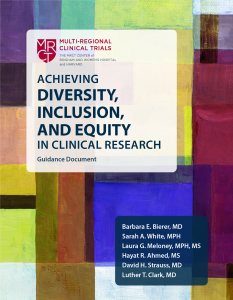Cultural Considerations in Clinical Research
 Culture is defined as the shared ideas, meanings, and values acquired by individuals as members of society (from: Health Literacy: A prescription to end confusion). Broadly, then, culture is a way of life for a group of people. At the same time, culture can mean different things to different people and can be challenging to generalize – especially since a single person can belong to and identify with many different cultures (race, ethnicity, gender identity, sexual orientation, language, profession, etc).
Culture is defined as the shared ideas, meanings, and values acquired by individuals as members of society (from: Health Literacy: A prescription to end confusion). Broadly, then, culture is a way of life for a group of people. At the same time, culture can mean different things to different people and can be challenging to generalize – especially since a single person can belong to and identify with many different cultures (race, ethnicity, gender identity, sexual orientation, language, profession, etc).
Members of the clinical research enterprise are often used to thinking in categories while seeking definitive answers to pre-defined questions. Yet the complexities of culturally appropriate materials and interactions often require a more nuanced approach – social and cultural contexts do not necessarily fit into discrete categories. Further, the way members of the research community think about their study populations is informed by their own personal experiences and is influenced by the experiences of the individuals being recruited and enrolled in research.
How can the clinical research enterprise better account for these cultural considerations?
In this section are tips, as well as examples, of how health literacy and cultural considerations intersect in the clinical research context.
The Connection between Culture, Health Literacy, and Clinical Research
Why Cultural Considerations Apply to Clinical Research
Processes to Support Health Literate Cultural Considerations
The Connection between Culture, Health Literacy, and Clinical Research
How cultural considerations apply to clinical research:
- Cultural Awareness
- Clinical research stakeholders can recognize that different experiences and influences contribute to what makes a unique individual – especially differences in attitudes and values that could influence research awareness, recruitment, and retention.
- Cultural Competency
- Clinical research stakeholders can deliver research-related services that meet the multifaceted needs of participants and their caregivers encompassing not only an understanding of the study participants, but also implementation of this awareness in research design, conduct and interpretation.
- Cultural Humility
- Clinical research stakeholders can take their awareness of the differences that others experience and deliver services based on that awareness as well as examining how personal beliefs, cultural identities, assumptions, biases and values can affect medicine and research practices.
- Learn more
Culture, considered in the design, conduct and oversight of clinical research, includes
- the bi-directionality of information exchange,
- the limits of knowledge on both sides of the exchange,
- an openness and curiosity to understanding the perspectives of others and how those might influence a willingness to consider, enroll, or stay, in a research study.
Engaging patients and participants is a critical part of considering culture.
Culture informs behavior and connects to participant engagement. If participants can’t be recruited and retained, the study will not be successful
Why Cultural Considerations Apply to Clinical Research
Cultural considerations apply to research because diversity is essential to the generalizability of study findings and ultimately usability of results, like being able to recognize if a medicine/vaccine has a different efficacy or side effects in different subgroups.
Members of the study population might bring different cultural values, lived experiences and personal challenges to each clinical research encounter.
Thoughtful attempts to incorporate cultural considerations helps to facilitate positive research interactions and successful research participation
Equitable access to research is supported when a broad construct of culture is adopted.
This means:
- not making assumptions about the study population
- exploring the needs and desires of the study population when developing the study question and outcomes,
- incorporating input from people who are like your study population about recruitment, consent, and other study-related information and procedures, including study design, when appropriate.
Processes to Support Clear Cross-Cultural Communication
Involve patients and participants early to ensure that the proposed research accounts for the self-reported needs of the study population. As part of the process, review characteristics that are likely to present a challenge to participant recruitment, consent, and ongoing participation in order to anticipate issues and trouble-shoot potential solutions early in the process.
- Example – Study Team
- Identifying that members of the study population may have caregiving responsibilities that limit their ability to come to the study site, might allow the study team to consider remote visits during the study planning process (including applicable budgeting considerations).
- Example – IRB
- Learning that recruitment and retention efforts may be impacted by housing insecurity might help the IRB consider more intensive follow-up methods than usual in order for the study team to collect the necessary research data from hard to track study participants.
- Example – Sponsor
- Considering whether members of the study population have religious affiliations that involve fasting and might impact the way a study medication is taken could be critical to the outcome of a clinical research study. If known in advance, however, sponsors may be able to plan to accommodate the situation. For example, by adjusting the times of study medications so that patients only need to take them 1-2 times per day.
Test your clinical research materials with users who are like the people who might be recruited and enrolled into the study.
More information about usability testing can be found here.
Spend time addressing potential biases against the intended audience to circumvent possible negative effects on the research study processes and procedures.
This is important for study team members who may interact with study participants, but is also relevant to others (such as, study sponsors and IRBs) who may need to consider how their own biases might impact the way a study’s inclusion/exclusion criteria are written or affect the review of a recruitment letter.
Examine Your Own Beliefs, Values and Practices.
Given a specific belief, ask yourself:
- Do I still believe in this?
- Why do I believe in this?
- What are the benefits of this belief?
- Should I look further and consider other beliefs?
- How can I prevent this belief from affecting my work with clinical research participants?
Additional Resources that Support Cultural Considerations
The MRCT Center has developed a comprehensive resource to support diversity, inclusion and equity in clinical research. Learn more here.


